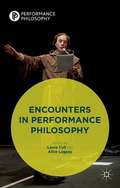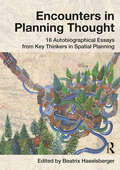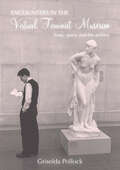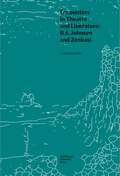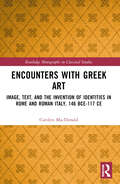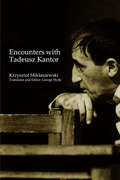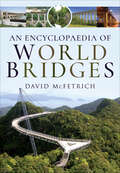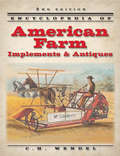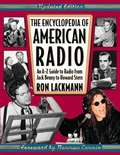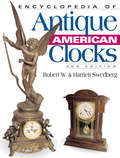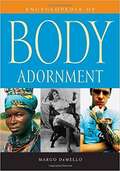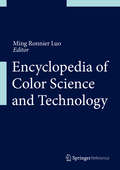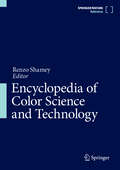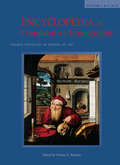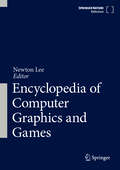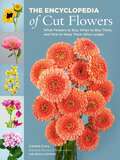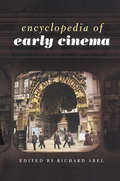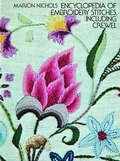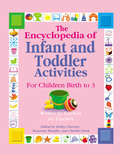- Table View
- List View
Encounters in Performance Philosophy
by Laura Cull Alice LagaayEncounters in Performance Philosophy is a collection of 14 essays by international researchers which demonstrates the vitality of the field of Performance Philosophy. The essays address a wide range of concerns common to performance and philosophy including: the body, language, performativity, mimesis and tragedy.
Encounters in Planning Thought: 16 Autobiographical Essays from Key Thinkers in Spatial Planning
by Beatrix HaselsbergerEncounters in Planning Thought builds on the intellectual legacy of spatial planning through essays by leading scholars from around the world, including John Friedmann, Peter Marcuse, Patsy Healey, Andreas Faludi, Judith Innes, Rachelle Alterman and many more. Each author provides a fascinating and inspiring unravelling of his or her own intellectual journey in the context of events, political and economic forces, and prevailing ideas and practices, as well as their own personal lives. This is crucial reading for those interested in spatial planning, including those studying the theory and history of spatial planning. Encounters in Planning Thought sets out a comprehensive, intellectual, institutional and practical agenda for the discipline of spatial planning as it heads towards its next half-century. Together, the essays form a solid base on which to understand the most salient elements to be taken forward by current and future generations of spatial planners.
Encounters in the Virtual Feminist Museum: Time, Space and the Archive
by Griselda PollockContinuing her feminist reconceptualisation of the ways we can experience and study the visual arts, world renowned art historian and cultural analyst, Griselda Pollock proposes a series of new encounters through virtual exhibitions with art made by women over the twentieth century. Challenging the dominant museum models of art and history that have been so exclusive of women's artistic contributions to the twentieth century, the virtual feminist museum stages some of the complex relations between femininity, modernity and representation.Griselda Pollock draws on the models of both Aby Warburg's Mnemosyne Atlas and Freud's private museum of antiquities as well as Ettinger's concept of subjectivity as encounter to propose a differencing journey through time, space and archive. Featuring studies of Canova 's Three Graces and women artist's modernist reclamations of the female body, the book traverses the rupture of fascism and the Holocaust and ponders the significance of painting and drawing in their aftermath. Artists featured include: Georgia O'Keeffe, Josephine Baker, Gluck, Charlotte Salomon, Bracha Ettinger and Christine Taylor Patten.
Encounters in Theatre and Liberature: B.S. Johnson and Zenkasi (Topographies of (Post)Modernity: Studies in 20th and 21st Century Literature in English)
by Katarzyna BielaIn his essay-manifesto of 1999, Zenon Fajfer defined liberature – a literary genre encompassing works whose authors intentionally design the shape of the book, so that it matches their textual message. Extending beyond the growing literary research on liberature, this book presents the theatrical contexts of the genre. Grounded in original archival research, it discusses the theatre practice of Zenon Fajfer and Katarzyna Bazarnik (Zenkasi), as well as the post-war British avant-garde author, B.S. Johnson, whom they see as as a liberatic author avant la lettre. Tracking the connections between their work work in different media, the monograph considers how their theatrical experience may be related to the invention of unconventional aesthetic solutions in literature.
Encounters with Godard: Ethics, Aesthetics, Politics (SUNY series, Horizons of Cinema)
by James S. WilliamsEncounters with Godard takes the reader on a personal voyage into the sensory pleasures and polyphonic rhythms of Jean-Luc Godard's multimedia work since the late 1970s, from his feature films and video essays to his published writings, art books, and media performances. Godard, suggests James S. Williams, lays ethical claim to the cinematic, defined in the broadest terms as relationality and artistic resistance. An introductory chapter on the extended history of La Chinoise (1967), a film explicitly of montage, is followed by seven different types of critical encounters with Godard, encompassing the fields of art and photography, music and literature, and foregrounding themes of gender and sexuality, race and violence, mystery and emotion. The Godard who emerges here is a restless and radical experimenter who establishes new cinematic thresholds through new technology and expands the creative potential and free exchange of the archives. Williams examines works including Nouvelle vague (1990), Film socialisme (2010), Hélas pour moi (1993), and the magnum opus Histoire(s) du cinéma (1988–98). Wide-ranging and accessible, Encounters with Godard marks a major intervention in the study of film aesthetics and ethics while forging a vital dialogue with literature, history and politics, art and art history, music and musicology, philosophy, and aesthetics.
Encounters with Greek Art: Image, Text, and the Invention of Identities in Rome and Roman Italy, 146 BCE-117 CE (Routledge Monographs in Classical Studies)
by Carolyn MacDonaldEncounters with Greek Art sheds new light on the invention of ancient identities by focusing on encounters between viewers and artworks swept to Italy on the tides of Roman imperialism between 146 BCE and 117 CE.Bringing globalization theory to bear on a wide range of texts and images, MacDonald traces the construction and contestation of a critical nexus of categories: Greek versus Roman, and high culture versus low. As the book moves from text to image, from monumental to domestic space, and from the imperial capital to the towns of Italy, readers will discover how Greekness and Romanness were imagined and reimagined as contingent but powerful devices for grappling with the flux of images, objects, and individuals around the globalized world of the Roman empire.This book is intended for scholars, graduate students, and advanced undergraduates interested in Greek and Latin literature, Roman visual culture, identity in antiquity, and histories of globalization.
Encounters with Tadeusz Kantor (Routledge Harwood Polish And East European Theatre Archive Ser.)
by Krzysztof MiklaszewskiAn invaluable collection of documents and discussions of the work of one of the most significant theatre practitioners of the last fifty years.This unique set of reminiscences, written by one of the actors who worked closely with Kantor over a long period of time, ranges from the anecdotal to the theoretical. Kantor's work offers some of the most disconcerting allegories of Modernism and a quintessential expression of the unconscious during a bitter period of human history. Kantor's stern but affectionate guardianship of his troupe of travelling players comes off Miklaszewski's pages with warmth, humanity and humour.
An Encyclopaedia of World Bridges
by David McFetrichBridges are one of the most important artefacts constructed by man, the structures having had an incalculable effect on the development of trade and civilisation throughout the world. Their construction has led to continuing advances in civil engineering technology, leading to bigger spans and the use of new materials. Their failures, too, whether from an inadequate understanding of engineering principles or as a result of natural catastrophes or warfare, have often caused immense hardship as a result of lost lives or broken communications. In this book, a sister publication to his earlier An Encyclopaedia of British Bridges (Pen & Sword 2019), David McFetrich gives brief descriptions of some 1200 bridges from more than 170 countries around the world. They represent a wide range of different types of structure (such as beam, cantilever, stayed and suspension bridges). Although some of the pictures are of extremely well-known structures, many are not so widely recognisable and a separate section of the book includes more than seventy lists of bridges with distinctly unusual characteristics in their design, usage and history.
The Encyclopaedic Dictionary in the Eighteenth Century: Architecture, Arts and Crafts (Routledge Revivals #Vol. 5)
by Terence M. RussellFirst published in 1997, this volume examines two of Sir Francis Bacon’s civil essays, Sir Henry Wotton’s The Elements of Architecture and John Harris’ Lexicon Technicum parts I and II.
Encyclopedia of American Farm Implements & Antiques
by C H WendelThe evolution of the modern farm Finally, an encyclopedia reference work covering American farm implements and farm-related antiques from the 1800s through the 1940s. Through Encyclopedia of American Farm Implements & Antiques, follow the exciting and fascinating technological advances in farm equipment that made the United States the breadbasket to the world. Thoroughly researched, this guide features nearly 2,000 rare illustrations of farm equipment - the most poplar to the most obscure - from firms such as Deere & Co., J.I. Case, Allis-Chalmers, International Harvester and McCormick. Trace the history of: Alfalfa Grinders Balers Corn Binders Corn Harvesters Cultivators Elevators Drills Hay Tools Milking Machines Plows Saws Threshers Washing Machines Plus Much More! If you have an interest in farming and history, you'll love Encyclopedia of American Farm Implements & Antiques. Not only does it identify and illustrate farm equipment, but it explains how this equipment was used and reveals many of the trials and tribulations farmers faced in using it. Also includes current price ranges for thousands of implements and antiques.
Encyclopedia of American Folk Art
by Gerard C. Wertkin Lee KoganFor a full list of entries, contributors, and more, visit the Encyclopedia of American Folk Art web site.This is the first comprehensive, scholarly study of a most fascinating aspect of American history and culture. Generously illustrated with both black and white and full-color photos, this A-Z encyclopedia covers every aspect of American folk art, encompassing not only painting, but also sculpture, basketry, ceramics, quilts, furniture, toys, beadwork, and more, including both famous and lesser-known genres.Containing more than 600 articles, this unique reference considers individual artists, schools, artistic, ethnic, and religious traditions, and heroes who have inspired folk art. An incomparable resource for general readers, students, and specialists, it will become essential for anyone researching American art, culture, and social history.
The Encyclopedia of American Radio: An A-Z Guide to Radio from Jack Benny to Howard Stern
by Ron LackmannRadio shows, personalities, chronology of radio events in the US and Canada, sponsors, vintage radio clubs, stations that feature vintage radio, logs of dramatic anthology shows
Encyclopedia of Antique American Clocks
by C H WendelFrom old schoolhouse clocks to stately grandfather clocks, the Encyclopedia of Antique American Clocks presents the most comprehensive guide to America's clocks. More than 700 photographs of clocks include detailed descriptions and current market values. The clocks are presented in an easy-to-follow format organized by clock type. Also included is information about the major clock manufacturers, and overview of clock types and a brief history of clock making. Arranged by clock type, the Encyclopedia of Antique American Clocks includes: Grandfather clocks Wall clocks Classic clocks Shelf clocks Novelty clocks Special chapters on: Clock types History of clock making Clocks from smaller clock makers Leading clock makers Glossary Bibliography Photo index
Encyclopedia of Body Adornment
by Margo DeMelloPeople everywhere have attempted to change their bodies in an effort to meet their cultural standards of beauty, as well as their religious and/or social obligations. Often times, this modification or adornment of their bodies is part of the complex process of creating and re-creating personal and social identities. <p><p> Body painting has probably been practiced since the Paleolithic as archaeological evidence indicates, and the earliest human evidence of tattooing goes back to the Neolithic with mummies found in Europe, Central Asia, the Andes and the Middle East. Adornments such as jewelry have been found in the earliest human graves and bodies unearthed from five thousand years ago show signs of intentional head shaping. <p><p> It is clear that adorning and modifying the body is a central human practice. Over 200 entries address the major adornments and modifications, their historical and cross-cultural locations, and the major cultural groups and places in which body modification has been central to social and cultural practices. <p><p> This encyclopedia also includes background information on the some of the central figures involved in creating and popularizing tattooing, piercing, and other body modifications in the modern world. Finally, the book addresses some of the major theoretical issues surrounding the temporary and permanent modification of the body, the laws and customs regarding the marking of the body, and the social movements that have influenced or embraced body modification, and those which have been affected by it.
Encyclopedia of Color Science and Technology
by Ming Ronnier LuoThe Encyclopedia of Color Science and Technology provides an authoritative single source for understanding and applying the concepts of color to all fields of science and technology, including artistic and historical aspects of color. Many topics are discussed in this timely reference, including an introduction to the science of color, and entries on the physics, chemistry and perception of color. Color is described as it relates to optical phenomena of color and continues on through colorants and materials used to modulate color and also to human vision of color. The measurement of color is provided as is colorimetry, color spaces, color difference metrics, color appearance models, color order systems and cognitive color. Other topics discussed include industrial color, color imaging, capturing color, displaying color and printing color. Descriptions of color encodings, color management, processing color and applications relating to color synthesis for computer graphics are included in this work. The Encyclopedia also delves into color as it applies to other domains such as art and design - ie - color design, color harmony, color palettes, color and accessibility, researching color deficiency, and color and data visualization. There is also information on color in art conservation, color and architecture, color and educations, color and culture, and an overview of the history of color and comments on the future of color. This unique work will extend the influence of color to a much wider audience than has been possible to date.
Encyclopedia of Color Science and Technology
by Renzo ShameyThis fully revised and expanded 2nd edition provides a single authoritative resource describing the concepts of color and the application of color science across research and industry. Significant changes for the 2nd edition include: New and expanded sections on color engineeringMore entries on fundamental concepts of color science and color termsMany additional entries on specific materialsFurther material on optical concepts and human visual perceptionAdditional articles on organisations, tools and systems relevant to colorA new set of entries on 3D presentation of color In addition, many of the existing entries have been revised and updated to ensure that the content of the encyclopedia is current and represents the state of the art. The work covers the full gamut of color: the fundamentals of color science; the physics and chemistry; color as it relates to optical phenomena and the human visual system; and colorants and materials. The measurement of color is described through entries on colorimetry, color spaces, color difference metrics, color appearance models, color order systems and cognitive color. The encyclopedia also has extensive coverage of applications throughout industry, including color imaging, color capture, display and printing, and descriptions of color encodings, color management, processing color and applications relating to color synthesis for computer graphics are included. The broad scope of the work is illustrated through entries on color in art conservation, color and architecture, color and education, color and culture, and biographies of some of the key figures involved in color research throughout history. With over 250 entries from color science researchers across academia and industry, this expanded 2nd edition of the Encyclopedia of Color Science and Technology remains the most important single resource in color science.
Encyclopedia of Comparative Iconography: Themes Depicted in Works of Art
by Helene E. RobertsFirst published in 1998. The Encyclopedia of Comparative Iconography compares the uses of iconographic themes from mythology, the Bible and other sacred texts, literature, and popular culture in works of art through various periods, cultures, and genres. Art historians now tend to study narrative themes depicted in works of art in relation to such subjects as gender and sexuality, politics and power, ownership and possession, ceremony and ritual, legitimacy and authority. The Encyclopedia of Comparative Iconography reflects these new approaches by ordering the themes of various iconographic sources in particular biblical, mythological, and literary texts according to these new emphases.Each handsomely illustrated entry discusses the major relevant iconographic narratives and the historical background of each theme. A list of selected works of art that accompanies each essay guides the reader to examples in art that depict the theme under discussion. Each essay includes a list of suggested reading that provides further sources of information about the themes. A general bibliography of reference books is listed separately and can be used in association with all the essays. With 119 entries written by 42 experts, the Encyclopedia of Comparative Iconography is an important reference work for art historians, students of art history, artists, and the general reader.
Encyclopedia of Computer Graphics and Games
by Newton LeeEncyclopedia of Computer Graphics and Games (ECGG) is a unique reference resource tailored to meet the needs of research and applications for industry professionals and academic communities worldwide. The ECGG covers the history, technologies, and trends of computer graphics and games.EditorNewton Lee, Institute for Education, Research, and Scholarships, Los Angeles, CA, USA Academic Co-ChairsShlomo Dubnov, Department of Music and Computer Science and Engineering, University of California San Diego, San Diego, CA, USAPatrick C. K. Hung, University of Ontario Institute of Technology, Oshawa, ON, CanadaJaci Lee Lederman, Vincennes University, Vincennes, IN, USAIndustry Co-ChairsShuichi Kurabayashi, Cygames, Inc. & Keio University, Kanagawa, JapanXiaomao Wu, Gritworld GmbH, Frankfurt am Main, Hessen, Germany Editorial Board MembersLeigh Achterbosch, School of Science, Engineering, IT and Physical Sciences, Federation University Australia Mt Helen, Ballarat, VIC, AustraliaRamazan S. Aygun, Department of Computer Science, Kennesaw State University, Marietta, GA, USABarbaros Bostan, BUG Game Lab, Bahçeşehir University (BAU), Istanbul, TurkeyAnthony L. Brooks, Aalborg University, Aalborg, DenmarkGuven Catak, BUG Game Lab, Bahçeşehir University (BAU), Istanbul, TurkeyAlvin Kok Chuen Chan, Cambridge Corporate University, Lucerne, SwitzerlandAnirban Chowdhury, Department of User Experience and Interaction Design, School of Design (SoD), University of Petroleum and Energy Studies (UPES), Dehradun, Uttarakhand, IndiaSaverio Debernardis, Dipartimento di Meccanica, Matematica e Management, Politecnico di Bari, Bari, ItalyAbdennour El Rhalibi, Liverpool John Moores University, Liverpool, UKStefano Ferretti, Department of Computer Science and Engineering, University of Bologna, Bologna, ItalyHan Hu, School of Information and Electronics, Beijing Institute of Technology, Beijing, ChinaMs. Susan Johnston, Select Services Films Inc., Los Angeles, CA, USAChris Joslin, Carleton University, Ottawa, CanadaSicilia Ferreira Judice, Department of Computer Science, University of Calgary, Calgary, CanadaHoshang Kolivand, Department Computer Science, Faculty of Engineering and Technology, Liverpool John Moores University, Liverpool, UKDario Maggiorini, Department of Computer Science, University of Milan, Milan, ItalyTim McGraw, Purdue University, West Lafayette, IN, USAGeorge Papagiannakis, ORamaVR S.A., Heraklion, Greece; FORTH-ICS, Heraklion Greece University of Crete, Heraklion, GreeceFlorian Richoux, Nantes Atlantic Computer Science Laboratory (LINA), Université de Nantes, Nantes, FranceAndrea Sanna, Dipartimento di Automatica e Informatica, Politecnico di Torino, Turin, ItalyYann Savoye, Institut fur Informatik, Innsbruck University, Innsbruck, AustriaSercan Şengün, Wonsook Kim School of Art, Illinois State University, Normal, IL, USARuck Thawonmas, Ritsumeikan University, Shiga, JapanVinesh Thiruchelvam, Asia Pacific University of Technology & Innovation, Kuala Lumpur, MalaysiaRojin Vishkaie, Amazon, Seattle, WA, USADuncan A. H. Williams, Digital Creativity Labs, Department of Computer Science, University of York, York, UKSai-Keung Wong, National Chiao Tung University, Hsinchu, TaiwanEditorial Board InternSa
The Encyclopedia of Cut Flowers: What Flowers to Buy, When to Buy Them, and How to Keep Them Alive Longer
by Calvert CraryFrom Calvert Crary and Bruce Littlefield, The Encyclopedia of Cut Flowers is a comprehensive, gorgeously visual guide that answers every question you've ever had (and a few you didn't know to ask!) about buying, caring for, and prolonging the lives of more than 140 different varieties of commonly available cut flowers.The Encyclopedia of Cut Flowers dives deep into the world of fresh-cut flowers, featuring unique entries for 143 different varieties of commonly available cut flowers that readers can buy at their local grocery store or flower market. Each flower entry offers authoritative tips for conditioning methods (eg–cut flowers should never be put near fresh fruit because fruit produces ethylene gas which will shorten the flowers' life), as well as scientific and common names, best seasons for buying (eg—lilies in spring, dahlias in summer) and fascinating facts about each bloom. An introductory section offers basic tips for styling arrangements at home, and for keeping flowers hydrated and alive for as long as possible. By the time readers are done flipping through the pages of The Encyclopedia of Cut Flowers, which features more than 150 gorgeous color photographs of flowers, they'll be experts in the field!
The Encyclopedia Of Drawing Techniques
by Neil Philip Running Press Staff Hazel HarrisonTo draw well depends on three things: observation, knowing how you want to translate what you see, and the physical ability to draw what you want. Here’s a complete course in the art of drawing, from core sections on pencil and pastel to the more esoteric techniques of sfumato and gestural drawing. More than 50 drawing techniques are shown in clear, detailed, step-by-step photography, plus a comprehensive overview of digital drawing techniques, with directions for modifying digital drawings using a visual effects wheel. ENCYCLOPEDIA OF DRAWING TECHNIQUES also features an inspirational gallery of some of the world’s finest drawings, demonstrating the full range of techniques in context.
Encyclopedia of Early Cinema
by Richard AbelThis encyclopedia presents a wealth of information on early cinema history, with coverage of the techniques and equipment of film production, profiles of the pioneering directors and producers, analysis of individual films and the rapid growth of distinct film genres, and the emergence of something the world had never seen before - the movie star.The work also focuses on how the nature of film exhibition changed as the industry grew, and how the public's reception to films also changed. The pre-cinema period is closely examined to show those mass-cultural forms and practices - such as music hall and vaudeville - from within which cinema was to emerge. A perfect companion for any student of early cinema and film studies.
Encyclopedia of Embroidery Stitches, Including Crewel
by Marion NicholsLet one of the most accomplished and creative crewel and embroidery experts into you home to teach you the ABCs of these increasingly popular handicrafts. Just turn the pages of this encyclopedic handbook and you will find her precise explanations and clear illustrations on how to work 178 different stitches and their variations.Logically organized for easy use, the book is divided into ten sections. Each is devoted to one of the basic families of stitches, differentiated from the others by its own distinctive motion. Taking one family at a time, the author classifies its various stitches into different groups -- such as isolated, isolated variations, line, angled line, grouped -- and explains them in their order of difficulty. The clear, lucid text and carefully drawn diagrams -- over 1,400 in all -- together present the step-by-step working of each stitch. Illustrations of both the front and back of finished stitches are included.Among the 178 stitches in such families as chain, straight, knotted, couched, and woven, are such variations as the Bosnian, Cable Outline, Whipped Satin, Lazy Daisy, Eyelet Buttonhole, Double Feather, Palestrina, Raised Lattice Band, and scores of others. In addition to the detailed working instructions, the author notes the basic rhythm of each stitch, direction of work, appropriate uses, and other pertinent information.This is an excellent workbook for all who want to learn these highly creative and satisfying stitches, and an ideal refresher course and reference for more experienced needleworkers.
An Encyclopedia of Gardening for Colored Children
by Jamaica KincaidA unique collaboration from two of America’s leading artists that explores the fascinating and hidden history of the plant world.In this witty, deeply original book, the renowned novelist Jamaica Kincaid offers an ABC of the plants that define our world and reveals the often brutal history behind them.Kara Walker, one of America’s greatest visual artists, illustrates each entry with provocative, brilliant, enthralling, many-layered watercolors.There has never been a book like An Encyclopedia of Gardening for Colored Children—so inventive, surprising, and telling about what our gardens reveal.
The Encyclopedia of Infant and Toddler Activities: For Children Birth to 3
by Kathy Charner Maureen Murphy Charlie ClarkWith over three hundred activities written specifically for infants and toddlers, this book will captivate children's imaginations and create wonderful opportunities for learning. The result of a nationwide contest, these activities were selected as the best of the best and are written by teachers, directors, and caregivers. Organized by time of day, teachers will love the easy-to-use format. Covering areas such as arrival and departure time, clean up, and transitions, the activities span a variety of developmental areas, including language, sensory, cognitive, social-emotional, and motor skills. Approved by teachers and loved by children, this resource is sure to be a classroom favorite.
Encyclopedia of Interior Design
by Joanna Banham Leanda ShrimptonFrom ancient Greece to Frank Lloyd Wright, studiola to smoking rooms, chimney boards to cocktail cabinets, and papier-mâché to tubular steel, the Encyclopedia of Interior Design provides a history of interior decoration and design from ancient times to the present day. It includes more than 500 illustrated entries covering a variety of subjects ranging from the work of the foremost designers, to the origins and function of principal rooms and furnishing types, as well as surveys of interior design by period and nationality all prepared by an international team of experts in the field. Entries on individuals include a biography, a chronological list of principal works or career summary, a primary and secondary bibliography, and a signed critical essay of 800 to 1500 words on the individual's work in interior design. The style and topic entries contain an identifying headnote, a guide to main collections, a list of secondary sources, and a signed critical essay.
